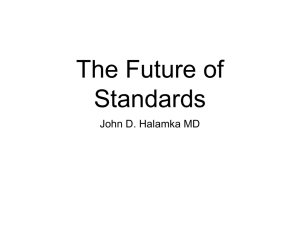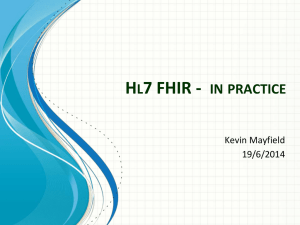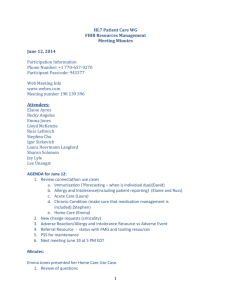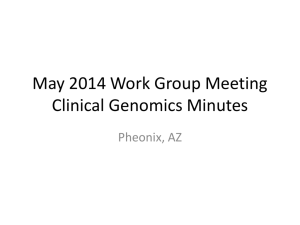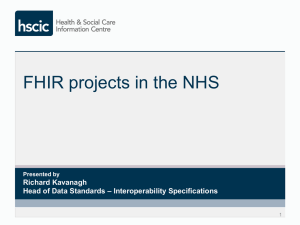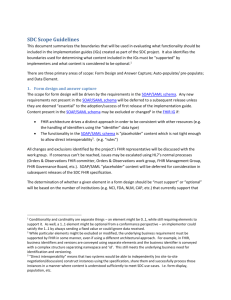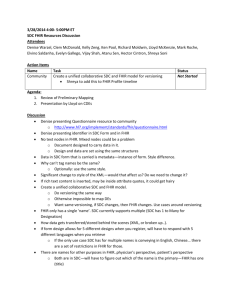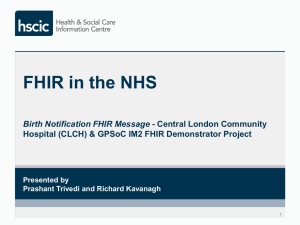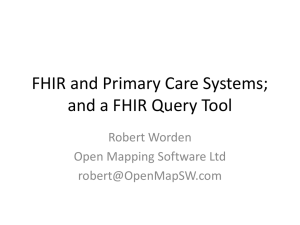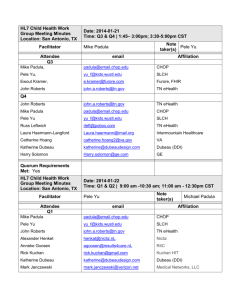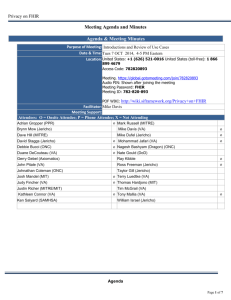FHIR and CIMI (Grahame Greeve)
advertisement
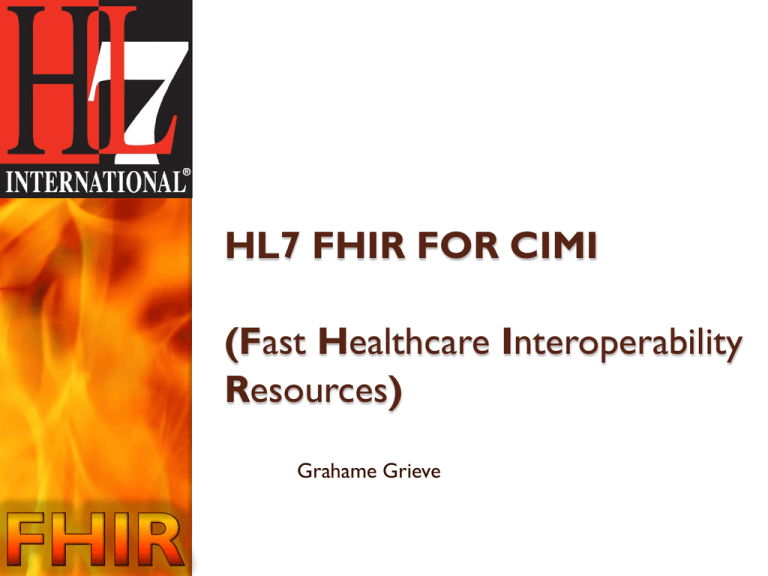
HL7 FHIR FOR CIMI (Fast Healthcare Interoperability Resources) Grahame Grieve Why FHIR? No one is happy with current HL7 positioning ◦ ◦ ◦ ◦ V2 old and tired V3 ambitious and flawed CDA limited and abused Tsunami of interoperability coming Fresh Look task force created CIMI ◦ CIMI addresses an important need ◦ But doesn’t address HL7’s problem: exchange of basic healthcare content FHIR Genesis If we were going to do something new now, how would we do it? Look around – who’s doing interoperability well ◦ Lots of roads lead to Highrise (37 Signals) Adapt the HighRise specification (Resources For Healthcare) HL7 liked that (a lot) Prior to last meeting, much development + rename to FHIR Who owns FHIR Prior to last HL7 meeting, I owned it (© Health Intersections) Now IP transferred to HL7 HL7 commits to making FHIR available for free Exact license still to be determined All hosted on HL7 servers http://www.hl7.org/fhir What is FHIR? Fast Healthcare Interoperability Resources Essentially HL7 v4 ◦ ◦ ◦ ◦ ◦ ◦ (won’t be marketed that way) New artifacts New methodology New tools New publishing approach Still built on RIM, vocab & datatypes, but more hidden FHIR Status All development by a small team (3-4 people) Yet to be balloted at all (for comment next cycle?) Internal governance yet to be finalised (tbd in Vancouver) Anything could change… FHIR Basics Build around the concept of “resources” ◦ Small, discrete concepts that can be maintained independently ◦ Clearly defined scope ◦ Aligns with RESTful design philosophy ◦ Each resource has a unique id ◦ Resources are smallest units of transaction 7 FHIR Basics (cont’d) Each resource is modeled using developer friendly XML ◦ XML does not reflect RIM-based modeling ◦ No classCodes, moodCodes, etc. visible ◦ Strong ontology behind the scenes that does link to RIM and vocabulary ◦ variant of the ISO data types – simplified, some changes due to different methodological constraints ◦ Strong focus on simplicity ◦ implementers do not need to know about the background methodology, but can leverage it if they want 8 RESTful Interfaces Resources can be used with a simple RESTful interface ◦ Predictable URL ◦ HTTP based atomic transactions for CRUD Operations Delete may not be honored and is not a true delete Use with a RESTful framework is not required ◦ Can aggregate resources into documents and send as a group ◦ FHIR provides a classic event (v2) based messaging framework ◦ Can use resources in custom services / SOA as desired FHIR Basics (cont’d) Built-in extension mechanism ◦ Extensions are defined using name, value, link-point Name is tied to robust terminology with full RIM modeling Link point identifies what element of the base resource or other extension the extension “attaches” to ◦ Idea is the elements used by 80% of implementers are part of the base resource. All other elements are handled as extensions ◦ Wire format remains stable, even as extensions occur 10 FHIR Basics (cont’d) Full support for textual mark-up ◦ In v3, only CDA provides for free-text mark-up for all elements. Messaging focuses on discrete data. ◦ With FHIR, all resources, as well as all resource attributes have a free-text expression, an encoded expression or both ◦ Conformance controls whether discrete data is required or not ◦ Ensures that FHIR can support the humanreadable interoperability delivered by CDA ◦ Mark up is xhtml directly 11 FHIR premises Design for the 80%, not 100% ◦ Only include data elements in the artifacts if 80% of all implementers of that artifact will use the data element Allow easy/stable extension for the remaining 20% of elements ◦ which often make up 80% of current specs ◦ Vocabulary approach to extension definition Focus publication on documenting what the implementer needs, not what the modelers thought or designers need to remember FHIR Products Specification UML diagrams Schemas Reference Implementations: ◦ ◦ ◦ ◦ Java, C#, Delphi, more Couch DB… eCore implementation OWL Structured definitions Resource representations Each resource is published with several views covering different aspects ◦ ◦ ◦ ◦ ◦ ◦ ◦ ◦ UML diagram Simple pseudo-XML syntax Vocabulary bindings Notes Search Criteria Data dictionary Example instance Schema Example - Person Example - Person Example - Person Example - Person Example - Person Example - Person Example - Person Example - Person FHIR Resource Profile A conformance profile: a statement of how a resource is used in a particular context ◦ Describes constraints on resources (constraint) ◦ Also describes what is added (extension) ◦ Links to other resource profiles for resource references (composition) ◦ A mash-up: building on top of the base resources Multiple ways to author a resource profile ◦ Should be interconvertible FHIR and CIMI FHIR and CIMI are very different things (scope, paradigm) Multiple ways to relate: ◦ FHIR could use CIMI definition framework in the background ◦ FHIR could produce CIMI definitions as part of it’s products ◦ CIMI could define clinical models as FHIR resource profiles (FHIR the way to deliver things) ◦ Pursue independent paths (for now…) and see what works
